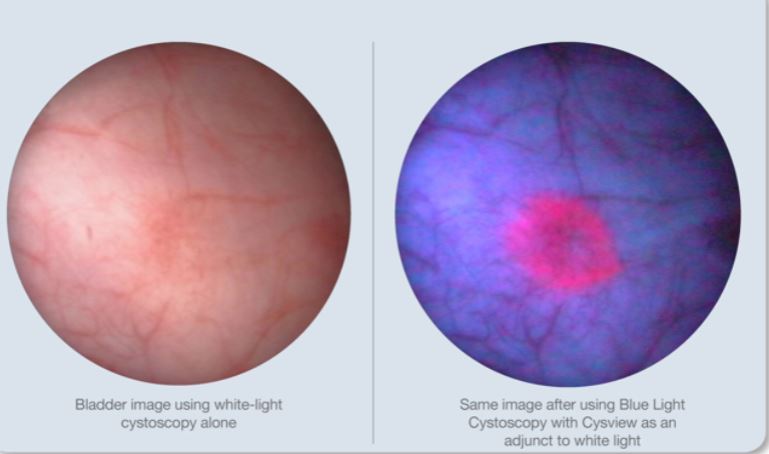
Used to improve detection of bladder cancers, Blue Light Cystoscopy with Cysview® significantly decreases cancer recurrence
Sylvester Comprehensive Cancer Center, part of the University of Miami Health System, is the only institution in South Florida offering fluorescence enhanced Blue Light Cystoscopy with Cysview®, an optical imaging agent for the detection of bladder cancer. Cysview is the only FDA-approved imaging agent for use with photodynamic diagnosis/fluorescence enhanced cystoscopy.
Chad R. Ritch, M.D., MBA, urologic oncologist at Sylvester Comprehensive Cancer Center, has already begun successfully using the technology which makes hard-to-see tumors that may be present in the bladder more visible, standing out against normal tissue and making it easier to identify and remove them.
Traditionally, when a tumor in the bladder is detected, doctors perform a transurethral resection, a surgical procedure where cancerous tissue is scraped out of the bladder.

White light cystoscopy has been the standard for visualizing these suspicious lesions during the resection. However, when used on its own, harder-to-see tumors can often be missed, leaving cancerous cells behind which can result in recurrence or spread of the residual cancer cells deeper into the bladder.
“Bladder tumors can be difficult to detect and have a high rate of recurrence,” said Ritch, who is assistant professor in the Department of Urology at the University of Miami Miller School of Medicine and performs the procedure at University of Miami Hospital. “Blue Light Cystoscopy enables us as physicians to see the tumors better, as well as, detect additional tumors that are often missed by standard white light cystoscopy. This leads to a more accurate diagnosis of bladder cancer.”
Cysview works by exploiting fluorescent properties of naturally occurring molecules which are then transformed into liquid and injected into the bladder one hour prior to the cystoscopy to coat its lining. Abnormal cancerous cells will absorb this molecule making them appear red when exposed to light from a specific wavelength. Physicians are then better able to detect and remove the red glowing cancer cells in contrast to normal tissue, which appears in blue.
Studies have shown that use of Blue Light Cystoscopy has resulted in a 16 percent increase in detection of bladder tumors and approximately 10 percent decrease in cancer recurrence. In addition, patients who undergo Blue Light cystoscopy have a longer time to recurrence compared to those who have traditional white light cystoscopy.
An author of the American Urological Association’s “Guideline for the Management of Non-muscle Invasive Bladder Cancer,” Ritch and colleagues performed extensive analysis of the medical data on bladder cancer diagnosis and concluded that Blue Light Cystoscopy is recommended at the time of initial resection of stage 1 bladder cancer.
Stephen Nimer, M.D., director of Sylvester Comprehensive Cancer Center, said “offering this more advanced technology to our patients is evidence that we continue to conduct the most promising cancer research to fulfill our mission to improve outcomes.”
“Being the only South Florida institution to offer patients Blue Light Cystoscopy with Cysview is in keeping with the Department of Urology’s commitment to advancing patient care in our field,” said Dipen Parekh, M.D., the Victor Politano Endowed Chairman of Urology at the Miller School of Medicine, and urologic oncologist at Sylvester. “This expertise is why we are the largest referral center for bladder cancer in South Florida.”
Bladder cancer is the sixth most commonly diagnosed cancer in the United States. The American Cancer Society estimates that 72,570 new cases of bladder cancer are diagnosed in the U.S. each year. Approximately 50-60 percent of patients with stage I bladder cancer may have their tumor recur.
For more information or to make an appointment at Sylester Comprehensive Cancer Center (305) 243-6630 or (305) 243-6090 or visit www.sylvester.org or http://urology.med.miami.edu/






